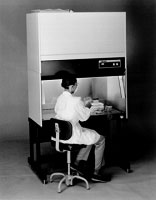What happened to the Class II Type A/B3 Biosafety Cabinet?
The Class II Type A/B3 Biosafety Cabinet has been replaced by the Class II Type A2 BSC
 NSF International modified NSF/ANSI Standard 49 in 2002 to replace the Type A/B3 biosafety cabinet configuration with the Type A2. Type A/B3 cabinets ceased to be manufactured by all producers of Class II BSCs in the mid 2000s.
NSF International modified NSF/ANSI Standard 49 in 2002 to replace the Type A/B3 biosafety cabinet configuration with the Type A2. Type A/B3 cabinets ceased to be manufactured by all producers of Class II BSCs in the mid 2000s.
Type A/B3 cabinets were designed to recirculate their air back to the lab for work not involving chemicals. If minute amounts of chemicals were used, Type A/B3 cabinets could also be exhausted with a hard duct connection to the outside of the building – a design connection that could lead to unstable BSC airflows and the potential for positively pressurized ductwork.
A Type A2 cabinet’s exhaust exhaust can be recirculated to the room or canopy connected to an external exhaust duct, like both of the configurations for a Type A/B3. However, when connected to exhaust ductwork, an A2 provides safer operation. The A2 design uses a canopy connection (sometimes called a ‘thimble’ connection), which acts as a buffer between the Type A2’s internal exhaust fan and the building’s remote exhaust fan. NSF-approved canopy connections prevent the opportunity for positively pressurized ductwork, and eliminate the chance for the biosafety cabinet to experience airflow imbalances to inflow and downflow velocities. The design of a canopy connected A2 also includes an exhaust alarm, which notifies the user when the building’s exhaust airflow is insufficient.
If you have more questions about Biological Safety Cabinets, please feel free to contact us directly.
| chevron_left | What are the biosafety cabinet classes? | Articles | Can I really use a C1 instead of a B2? How is it more beneficial? | chevron_right |






